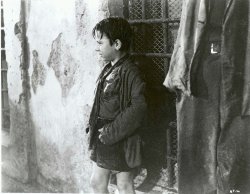Is It Really a Great Movie? Part Twenty-One: The Bicycle Thief
by dan heaton
Using Roger Ebert's Great Movies book as a guide, this series of articles will focus on all films included on his list that previously have escaped my notice. Since all lists are subjective, I am not treating Ebert's choices as the essential selection of films. However, his essays offer the perfect chance for me to explore both classics and lesser-known pictures from around the globe.

Vittorio De Sica’s 1948 neorealist picture The Bicycle Thief has reached a point where even people who’ve never seen the film speak about its uncompromising artistry. 1992’s The Player used it to exemplify a non-Hollywood film, and it even received a mention in the ‘90s cult television series My So-Called Life. In that show, the movie spawns an argument between platonic friends Angela (Claire Danes) and Brian (Devon Gummersall) because she wants to take her clueless boyfriend to see the film they’d already watched together. These examples reveal how this film has moved into popular culture and help to explain the mournful story’s considerable impact. Following its U.S. release, the Academy actually created an Honorary Oscar to recognize its power. Countless other awards were also bestowed on the picture, but it does not share the exalted status of other classics today. Has The Bicycle Thief lost its effect on modern audiences?
The basic plot is deceptively simple: A man needs his bike for a job, the bike is stolen, and he must get it back. Situated within the devastating conditions of post-war Rome, the struggle to recover this bike becomes more than a search for property. Lamberto Maggiorani stars as Antonio, an unemployed guy trying to provide for his wife and two children. Unfortunately, jobs are extremely scarce, so the opportunity to hang posters around town is very positive. After recovering his bike by pawning their sheets, the future looks bright, but the thief changes everything. Locating this bike within such a large city seems nearly impossible, but few choices remain without it. Taking his young son Bruno (Enzo Staiola) on the journey, they follow the clues through the bleak environment and hope for a miracle to save his job.
This film contains moments of despair and unfortunate realism that stay with you for a long time. When Antonio and his wife Maria (Lianella Carell) pawn their bed sheets, a long shot reveals an extremely high, factory-style storage area that includes countless sheets. The streets of Rome are filled with sour citizens looking hungry and desperate, especially while waiting in line for the packed buses. Moments of whimsy do occur within this bleak environment, but they are fleeting and never outweigh the difficult situation. Antonio and Bruno catch a break and follow an old man into a church, which creates a ruckus in the crowded house of worship. This crotchety guy may know the thief, and their attempts to speak with him are complicated by the serene location. The church is an interesting setting because it would seem necessary for people struggling to stay afloat. However, De Sica does not portray this setting with solemnity. Instead, it serves as a troubling annoyance for Antonio while he tries to locate the young thief.
De Sica used an entire cast of amateur actors for this picture, which enhanced the realities of the lead characters’ struggles. Maggiorani’s work is strong and effectively conveys Antonio’s attempts to retain hope. When he finally takes Bruno to an Italian restaurant for a quick bite, they glimpse the life of a wealthier class. This scene is one of their few moments of fun, and it offers a brief possibility of a happy ending. It is one of the film’s best sequences, and is necessary to keep the story from drifting into too much sadness. When the expected shift into gloominess occurs, it remains moving because we’ve viewed their dreams of attaining a more secure life.
The Bicycle Thief offers an interesting tale of one man’s struggle against serious odds. However, I found it to be fairly underwhelming as a complete film. The unique style is notable and its place in history is not a surprise, but its overall effect was limited. Roger Ebert praises the film because of how “simple, direct, and true” it is. I cannot deny the straightforward, real-life connections that are present, but this approach does feel dated when viewed from a modern perspective. I believe it is a solid film that falls short of deserving a place within a Great Movies list. Finally seeing De Sica’s acclaimed vision was a worthwhile experience, but I never became completely engrossed in the basic story.
Copyright (c) 2007 erasing clouds |
|